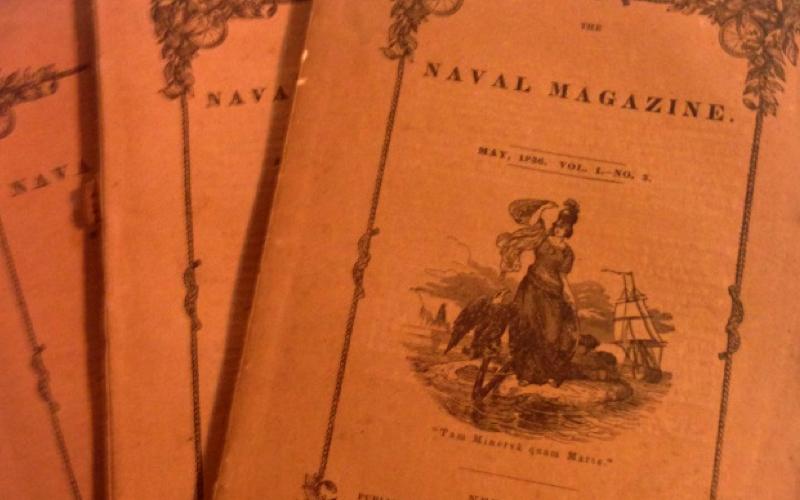(W)Archives: The Naval Lyceum and the First “X” Article

If we define an era of naval enlightenment as a rising tide of junior officers guided by more senior officers gathered together to think, speak, and write about their profession, then the United States Navy has undergone three distinct periods that meet this definition. The most recent such period covers the past decade, during which junior officers wrote in both traditional and online media, and self-organized through groups such as the Center for International Maritime Security (CIMSEC) to discuss current and future military challenges. Before that came a period at the end of the 19th century, when the U.S. Naval Institute and the Naval War College were founded. During this period a generation of naval officers such as Alfred Thayer Mahan, Stephen B. Luce, Williams Sims, and others joined with like-minded navalist politicians such as Theodore Roosevelt and Henry Cabot Lodge to stress the importance of the Navy’s global role. However, the original age of naval enlightenment occurred in the 1830s, when officers like Matthew Perry charted the course with the founding the Naval Lyceum.
The Lyceum was organized in 1833 at the Brooklyn Navy Yard under President Commodore Charles Ridgely and First Vice President Master Commandant Matthew Perry. Its records are maintained at the United States Naval Academy Museum in Annapolis, Maryland. According to the organization’s charter, the Lyceum was founded to:
Elevate and adorn the character of our Navy, by placing within the grasp of its officers the means of acquiring professional and general information … to stimulate the members of the profession, by creating a common interest in the result, to new energy in the steady and zealous pursuit of knowledge, as the grand source of moral power, and to bind yet more closely the ties which unite them, by erecting a National Society.
It counted among its members most of the officers of the Navy as well as a few Army officers, at least four British captains, shipbuilders and designers. Among the honorary members were Presidents Andrew Jackson, Martin van Buren, James Madison, and John Quincy Adams. Even literary figures such as Washington Irving and James Fenimore Cooper were active members.
[widgets_on_pages id=3]
Two years after organizing and meeting every Monday afternoon — initially in Perry’s office and later in the Lyceum’s own building — they began publishing the quarterly Naval Magazine, (some issues of which are available online), the first American periodical of the naval profession. Many of its authors wrote under pseudonyms. One example was “X” who penned the July 1836 article “On Steamers of War,” that is this week’s document.
Though the U.S. Navy was scarcely in the steam age in 1836, “X” already had a sophisticated view of the power of steam to literally and figuratively propel the Navy into a new era, even while recognizing the limitations of the time. The author provided a brief history of the introduction of steam technology into the U.S. Navy with the Fulton (aka Demalogos). “The first attempt,” he notes,” was naturally enough a very rude one. The vessel was clumsy, cumbersome, and very slow in her movements … The formidable character of this vessel was, however, never tested.” “X” suggested, however, that steam ships would have been “eminently useful” in the suppression of piracy in the West Indies.
More importantly, “X” described how other countries were adopting steam in their warships. At that time, England had 21 steam warships and France had 23. The United States had no operating steam warships that year. “X” discussed how the British ships-of-the-line were being retrofitted with steam auxiliary propulsion. If the other great powers were using these ships, then so, too, must the United States. “Steamers,” he was convinced, “must henceforth take a prominent part in every future naval war … to cross the ocean and make long voyages.” Already, “X” saw threats to the south in the Gulf of Mexico. “We should, at this very moment, have several steamers of war moving along the coasts of Texas and Mexico, to protect our extended commerce from the depredations of the belligerents, and from the piracies which will inevitably grow out of the civil war now raging there.”
The author “X” was likely Perry himself, known today as the “Father of the Steam Navy.” He had served in the West Indies facing pirates in the 1820s (when one steamship was used to support operations), and in the late 1830s was sent to Europe to study the latest in steam warship designs. Within a decade, Perry commanded the USS Mississippi — a steam ship whose construction he had overseen. Later he succeeded Commodore David Conner in overall command of the Navy’s steam ships. Though the move toward steam propulsion was a gradual process in the U.S. Navy during the 19th century, its employment during the Civil War signaled that Perry — or “X” — was right in championing this technology.
The Lyceum was most active during the 1830s and waned over the next few decades until it was eclipsed by the Naval Institute. The Naval Magazine itself was only published for two years — in 1836 and 1837. However, pieces such as the “X” article and those on advancing naval education and personnel reform helped make the short-lived Naval Magazine an integral component of the early republic’s Navy, and just as War on the Rocks does today, it provided a venue for the debate of new — even revolutionary — ideas.
Claude Berube is an instructor at the U.S. Naval Academy and Director of the Naval Academy Museum. He is a contributor to War on the Rocks. His fifth book and second novel SYREN’S SONG, will be published in November through Naval Institute Press. Follow him on Twitter @cgberube.

